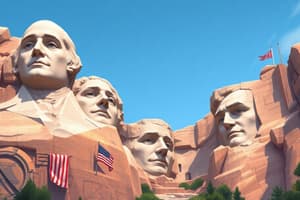Podcast
Questions and Answers
Who was the sculptor responsible for the creation of the Mount Rushmore National Memorial?
Who was the sculptor responsible for the creation of the Mount Rushmore National Memorial?
- Paul Manship
- Gutzon Borglum (correct)
- Frederick Hart
- John Auguste D. O'Connell
What year was the construction of Mount Rushmore completed?
What year was the construction of Mount Rushmore completed?
- 1941 (correct)
- 1950
- 1963
- 1935
Which of the following presidents is NOT depicted on Mount Rushmore?
Which of the following presidents is NOT depicted on Mount Rushmore?
- Thomas Jefferson
- James Madison (correct)
- George Washington
- Abraham Lincoln
What does George Washington represent in the symbolism of democracy as depicted at Mount Rushmore?
What does George Washington represent in the symbolism of democracy as depicted at Mount Rushmore?
How does Mount Rushmore impact local economies?
How does Mount Rushmore impact local economies?
Which of the following features is NOT a part of the visitor experience at Mount Rushmore?
Which of the following features is NOT a part of the visitor experience at Mount Rushmore?
What architectural techniques were utilized in the construction of Mount Rushmore?
What architectural techniques were utilized in the construction of Mount Rushmore?
Which value is Abraham Lincoln associated with in the context of the monument?
Which value is Abraham Lincoln associated with in the context of the monument?
What main purpose does the visitor center at Mount Rushmore serve?
What main purpose does the visitor center at Mount Rushmore serve?
What artistic goal did Gutzon Borglum have for Mount Rushmore?
What artistic goal did Gutzon Borglum have for Mount Rushmore?
Flashcards are hidden until you start studying
Study Notes
History Of The Monument
- The "Shrine of Democracy" refers to the Mount Rushmore National Memorial in South Dakota.
- Created by sculptor Gutzon Borglum, the project began in 1927 and was completed in 1941.
- The four presidents depicted are George Washington, Thomas Jefferson, Theodore Roosevelt, and Abraham Lincoln.
- The site was chosen for its visibility and the quality of granite.
- Funding was a mix of federal and state sources, with significant contributions from local tourism efforts.
Cultural Impact
- Mount Rushmore has become a symbol of American national pride.
- It attracts millions of visitors annually, influencing local economies and tourism.
- Often referenced in popular culture, literature, and films as an icon of American identity.
- It serves as a backdrop for various political events and speeches, reinforcing its status in American culture.
Symbolism Of Democracy
- Each president represents key values in American democracy:
- George Washington: Leadership and freedom.
- Thomas Jefferson: Enlightenment ideals and the Declaration of Independence.
- Theodore Roosevelt: Progressive reform and national strength.
- Abraham Lincoln: Unity and equality, especially during the Civil War.
- The monument symbolizes the collective American spirit and the nation's commitment to democratic ideals.
Visitor Experience
- Visitors can explore the site via a walking path that offers various viewpoints.
- The visitor center provides educational exhibits about the monument's history and significance.
- Seasonal events include lighting ceremonies and ranger-led tours.
- Accessibility features are in place to accommodate all visitors.
Architectural Significance
- The monument spans 60 feet high and each presidential face is about 20 feet tall.
- Utilizes a blend of classical and modern techniques in stone carving.
- The design reflects Borglum's vision of capturing the essence of each president.
- Engineering challenges were overcome, including rock blasting and careful planning for stability.
- The overall design integrates with the natural landscape, emphasizing harmony between art and nature.
History Of The Monument
- "Shrine of Democracy" refers to Mount Rushmore National Memorial in South Dakota.
- Sculpted by Gutzon Borglum, construction started in 1927 and was completed in 1941.
- Features four presidents: George Washington, Thomas Jefferson, Theodore Roosevelt, and Abraham Lincoln.
- Chosen site due to high visibility and quality granite for carving.
- Funded through federal and state sources, with significant support from local tourism initiatives.
Cultural Impact
- Mount Rushmore symbolizes American national pride and identity.
- Attracts millions of tourists yearly, boosting local economies and tourism industry.
- Commonly referenced in pop culture, literature, and films, reinforcing its iconic status.
- Serves as a venue for political events and speeches, further embedding its cultural significance.
Symbolism Of Democracy
- Each president embodies crucial democratic values:
- George Washington: Represents leadership and the concept of freedom.
- Thomas Jefferson: Symbolizes Enlightenment ideals and authorship of the Declaration of Independence.
- Theodore Roosevelt: Reflects progressive reform and national strength.
- Abraham Lincoln: Represents unity and equality, particularly during the Civil War.
- The monument signifies the collective American spirit and commitment to democratic ideals.
Visitor Experience
- A walking path allows visitors to explore various scenic viewpoints.
- The visitor center features educational exhibits detailing the monument's history and significance.
- Seasonal events include lighting ceremonies and ranger-led educational tours.
- Accessibility measures are in place to ensure all visitors can enjoy the site.
Architectural Significance
- The monument stands 60 feet high, with presidential faces measuring about 20 feet tall.
- Combines classical and modern stone carving techniques in its design.
- Reflects Borglum's aim to encapsulate the essence of each president within the rock.
- Overcame engineering challenges such as rock blasting and stability planning.
- The design harmonizes with the natural landscape, emphasizing a connection between art and nature.
Studying That Suits You
Use AI to generate personalized quizzes and flashcards to suit your learning preferences.




